Cross-Sectional Analysis of the Resistance of RC Members Subjected to Bending with/without Axial Force
Abstract
:1. Introduction
2. Ring Cross-Section Subjected to Bending with Axial Force
2.1. Derivation of Analytical Formulae for the Resistance
- The RC ring cross-section of outer radius R, inner radius r and thickness t = R − r is subjected to axial force N and bending moment M (Figure 1). The section may be unreinforced or reinforced with the reinforcing steel spaced at one or two layers, which can be replaced by a continuous ring of equivalent area located on the reference circumference of radius rs, r ≤ rs ≤ R. When rs = R or rs = r, this reinforcement is treated as an “external reinforcement”.
- For the section under combined compression and bending, the relations for strains in concrete εc (‰) and in reinforcing steel εs (‰) are given by the following.
2.2. Experimental Verification with Discussion of the Results
3. RC Rectangle Subjected to Bending without Axial Force
3.1. Derivation of the Ultimate Bending Moment
3.2. The Resistance of Composite Steel and Concrete Beams Versus Test Results
4. Conclusions
- The obtained solutions are presented in the form of interaction diagrams that satisfy the conditions of convexity in accordance with Drucker’s postulates. This means that they can be regarded as the actual carrying capacity curves.
- The proposed ring section models seem to have a wider application field than the previous ones, due to the assumptions of a noncentral layout of reinforcement and wall-edge strains. As a result, they are suitable for ring cross-sections with both the thin and moderate thicknesses. Furthermore, they can be easily adopted when structure strengthening is required by means of externally bonded CFRP, FRP or GFRP composites as well as for determining the resistance of composite steel and concrete columns.
- Using this approach, the similar formulae can be derived for other sections commonly encountered in the engineering practice, for example, a rectangle and the ones weakened by openings.
- It was proved that the computational results conform to those obtained by testing on RC eccentrically loaded columns.
- The analytical solution was developed for the resistance of RC rectangle subjected to bending without axial forces to determine ultimate bending moment MHRm of the composite steel and concrete beams.
- The comparisons made between the computational and test results of BH beams showed good agreements in ultimate bending moments.
- The above-developed models enabled the analysis of the behavior of RC members in the postcritical phase.
- They have been implemented in Excel to provide a useful tool for the dimensioning optimization of RC-designed members and structures that may result in a reduction in material consumption and a lesser impact on the environment.
- Further experimental work is needed concerning the postcritical behavior of RC members.
Funding
Institutional Review Board Statement
Informed Consent Statement
Data Availability Statement
Conflicts of Interest
Nomenclature
| fcd = fck/γc | design strength of concrete in compression |
| fck | characteristic strength of concrete in compression |
| γc | partial safety factor for concrete |
| fcm | mean compressive strength of concrete |
| fyk | yield stress of reinforcing steel |
| fyd = fyk/γs | design yield stress of reinforcing steel |
| γs | partial safety factor for steel |
| fHyk | yield stress of profile steel |
| Ecm | secant modulus of elasticity of concrete |
| Es | modulus of elasticity of steel (profile steel) |
| εc1 | strain at peak stress on the σc-εc diagram |
| εcu1, εcu | ultimate strain for concrete |
| ε1, ε2 | maximum and minimum compressive strains, respectively |
| εsu | ultimate strain for reinforcing steel |
| εHf | strain in the lower flange of profile steel |
| e | eccentricity |
| σc, εc | stress, strain in concrete |
| σs, εs | stress, strain in reinforcing steel |
| N | axial force |
| M | bending moment |
| Nu, Mu | ultimate axial force and ultimate bending moment, respectively |
| nRm, nu | normalized ultimate axial force |
| mRm, mu | normalized ultimate bending moment |
| b, t | dimensions of the rectangular cross-section |
| t1, t2 | coordinates describing the locations of rebars |
| x | coordinate describing the location of the neutral axis |
| σs1 | compressive stress of steel |
| σs2 | tensile stress of steel |
| μ1, μ2 | reinforcement ratios of steels in compression and in tension (rectangle) |
| μ | reinforcement ratio (ring) |
| R | outer radius |
| r | inner radius |
| t = R − r | thickness of ring |
| rm | mean radius |
| rs | radius describing the locations of reinforcing steel on the reference circumference |
| dm | mean diameter |
| α | angle describing the location of the neutral axis, rad |
| ρ coefficient | ρ = rs/rm |
| ρR coefficient | ρR = R/rm |
| maximum compressive strain in concrete, ‰ | |
| ; | |
| ϕ | angular coordinate, rad |
| dAs, dAc | element of the steel area As and of the concrete area Ac, respectively |
| Fa1, Fa2 | areas of reinforcing steels in compression and in tension, respectively |
References
- Knauff, M. Calculations of Reinforced Concrete Structures According to EC 2, 1st ed.; Scientific Publisher PWN: Warsaw, Poland, 2013. (In Polish) [Google Scholar]
- Nieser, H.; Engel, V. Structure of Industrial Chimneys, Commentary on DIN 1056, 1st ed.; Beuth Verlag GmbH: Berlin, Germany, 1986. [Google Scholar]
- International Committee on Industrial Chimneys. Model Code for Concrete Chimneys, Part A: The Shell, 2nd ed.; International Committee on Industrial Chimneys: Moers, Germany, 2011. [Google Scholar]
- Hognestad, E. Study of Combined Bending and Axial Load in Reinforced Concrete Members; Bulletin No. 399; University of Illinois Urbana: Champaign, IL, USA, 1951; p. 128. [Google Scholar]
- ACI 307–08; Code Requirements for Reinforced Concrete Chimneys and Commentary. American Concrete Institute: Farmington Hills, MI, USA, 2008.
- Popovics, S. A review of stress-strain relationships for concrete. ACI J. 1970, 67, 243–248. [Google Scholar]
- Popovics, S. A numerical approach to the complete stress-strain curve of concrete. Cem. Concr. Res. 1973, 3, 583–599. [Google Scholar] [CrossRef]
- Lechman, M. Resistance of RC annular cross-sections with openings subjected to axial force and bending. Eng. Trans. 2008, 56, 43–64. [Google Scholar]
- Lechman, M. Resistance of reinforced concrete columns subjected to axial force and bending. Transp. Res. Procedia 2016, 14, 2411–2420. [Google Scholar] [CrossRef] [Green Version]
- Lechman, M. A close to reality method for determining the resistance of RC structures under eccentric compression. Procedia Eng. 2017, 193, 58–65. [Google Scholar] [CrossRef]
- Majewski, T.; Bobiński, J.; Tejchman, J. FE analysis of failure behavior of reinforced concrete columns under eccentric compression. Eng. Struct. 2008, 30, 300–317. [Google Scholar] [CrossRef]
- Rodrigues, E.A.; Manzoli, O.L.; Bitencourt, L.A.G., Jr.; dos Prazeres, P.G.C.; Bitencourt, T.N. Failure behavior modeling of slender reinforced concrete columns subjected to eccentric load. Lat. Am. J. Solids Struct. 2015, 12, 520–541. [Google Scholar] [CrossRef] [Green Version]
- Kim, J.K.; Lee, S.-S. The behavior of reinforced concrete columns subjected to axial force and biaxial bending. Eng. Struct. 2000, 23, 1518–1528. [Google Scholar] [CrossRef]
- Lloyd, N.A.; Rangan, B.V. Studies on high-strength concrete columns under eccentric compression. ACI Struct. J. 1996, 93, 631–638. [Google Scholar]
- Chruściel, W. An Advanced Method for Calculating the RC Ring Cross-Section under Eccentric Compression. Ph.D. Thesis, Building Research Institute, Warsaw, Poland, 2013. [Google Scholar]
- Trapko, T.; Musiał, M. The effectiveness of CFRP materials strengthening of eccentrically compressed reinforced concrete columns. Arch. Civ. Mech. Eng. 2011, 11, 249–262. [Google Scholar] [CrossRef]
- Campione, G.; Fosetti, M.; Papia, M. Behavior of fiber-reinforced concrete columns under axially and eccentrically compressive loads. ACI Struct. J. 2010, 107, 272–281. [Google Scholar]
- El Maaddawy, T.; El Sayed, M.; Abdel-Magid, B. The effect of cross-sectional shape and loading condition on performance of reinforced members confined with carbon fiber-reinforced polymers. Mater. Des. 2010, 31, 2330–2341. [Google Scholar] [CrossRef]
- Elwan, S.; Rashed, A. Experimental behavior of eccentrically loaded RC short columns strengthened using GFRP wrapping. Struct. Eng. Mech. 2011, 39, 207–221. [Google Scholar] [CrossRef]
- Sadeghian, P.; Rahai, A.; Ehsani, M. Experimental study of rectangular RC columns strengthened with CFRP composites under eccentric loading. J. Compos. Constr. 2010, 14, 443–450. [Google Scholar] [CrossRef]
- Eid, R.; Paultre, P. Compressive behavior of FRP-confined reinforced concrete columns. Eng. Struct. 2017, 132, 518–530. [Google Scholar] [CrossRef]
- Wu, Y.; Jiang, C. Effect of load eccentricity on the stress-strain relationship of FRP-confined concrete columns. Compos. Struct. 2013, 98, 228–241. [Google Scholar] [CrossRef]
- Quiertant, M.; Clement, J. Behavior of RC columns strengthened with different CFRP systems under eccentric loading. Constr. Build. Mater. 2011, 25, 452–460. [Google Scholar] [CrossRef]
- Evirgen, B.; Tuncan, A.; Taskin, K. Structural behavior of concrete filled steel tubular sections (CFT/CFST) under axial compression. Thin-Walled Struct. 2014, 80, 46–56. [Google Scholar] [CrossRef]
- Han, L.-H.; Li, W.; Bjorhovde, R. Developments and advanced applications of concrete –filled steel tubular (CFST) structures: Members. J. Constr. Steel Res. 2014, 100, 211–228. [Google Scholar] [CrossRef]
- Huang, H.; Han, L.-H.; Tao, Z.; Zhao, X.-L. Analytical behavior of concrete-filled double skin steel tubular (CFDST) stub columns. J. Constr. Steel Res. 2010, 66, 542–555. [Google Scholar] [CrossRef]
- Qu, X.; Chen, Z.; Sun, G. Experimental study of rectangular CFST columns subjected to eccentric loading. Thin-Walled Struct. 2013, 64, 83–93. [Google Scholar] [CrossRef]
- Lechman, M.; Stachurski, A. Determination of stresses in RC eccentrically compressed members using optimization methods. AIP Conf. Proc. 2018, 1992, 130003. [Google Scholar]
- Lewiński, P.M.; Więch, P.P. Analytical model and numerical research of composite beams with horizontal studs. In Proceedings of the 8th International Conference “Analytical Models and New Concepts in Concrete and Masonry Structures”, Wrocław, Poland, 16–18 June 2014. [Google Scholar]
- Lewiński, P.M.; Derysz, J.; Dudziak, S.; Więch, P.P. Newly designed structural solutions for the “Slim floor” composite system. In Proceedings of the Fib Symposium 2019—Concrete: Innovations in Materials, Design and Structures, Krakow, Poland, 27–29 May 2019. [Google Scholar]
- Lechman, M. Analytical solution for the resistance of composite beams subjected to bending. MATEC Web Conf. 2020, 323, 01013. [Google Scholar] [CrossRef]
- EN 1994-1-1:2004; Eurocode 4: Design of Composite Steel and Concrete Structures—Part 1-1: General rules and rules for buildings. European Union: Brussels, Belgium, 2005.
- Elnashai, A.S.; Papazoglou, A.J. Procedure and spectra for analysis of RC structures subjected to strong vertical earthquake loads. J. Earthq. Eng. 1997, 1, 121–155. [Google Scholar] [CrossRef]
- Parisi, F.; Augenti, N. Influence of seismic design criteria on blast resistance of RC framed buildings: A case study. Eng. Struct. 2012, 44, 78–93. [Google Scholar] [CrossRef]
- Noble, D.; Nogal, M.; O’Connor, A.; Pakrashi, V. The effect of prestress force magnitude and eccentricity on the natural bending frequencies of uncracked prestressed concrete beams. J. Sound Vib. 2016, 365, 22–44. [Google Scholar] [CrossRef] [Green Version]
- Bonopera, M.; Chang, K.-C.; Chen, C.-C.; Sung, Y.-C.; Tullini, N. Prestress force effect on fundamental frequency and deflection shape of PCI beams. Struct. Eng. Mech. 2018, 67, 255–265. [Google Scholar]
- Vlase, S.; Marin, M.; Deaconu, O. Vibration properties of a concrete structure with symmetries used in civil engineering. Symmetry 2021, 13, 656. [Google Scholar] [CrossRef]
- Drucker, D.C. A definition of a stable inelastic material. ASME J. Appl. Mech. 1959, 26, 101–195. [Google Scholar] [CrossRef]
- EN 1992-1-1: 2010; Eurocode 2: Design of Concrete Structures—Part 1-1: General rules and rules for buildings. European Union: Brussels, Belgium, 2004.
- Hill, R. General theory of uniqueness and stability in elastic-plastic solids. J. Mech. Phys. Solids 1958, 6, 236–249. [Google Scholar] [CrossRef]
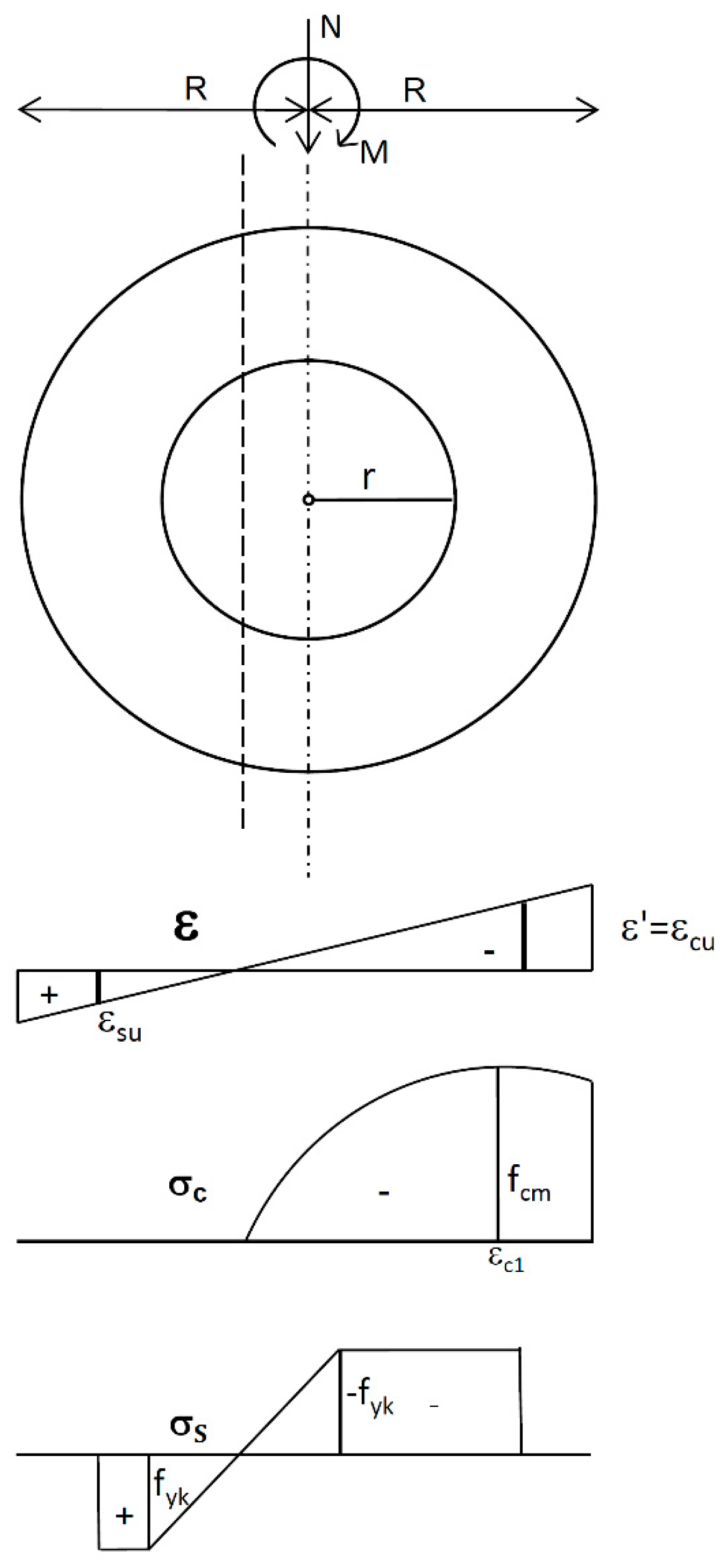

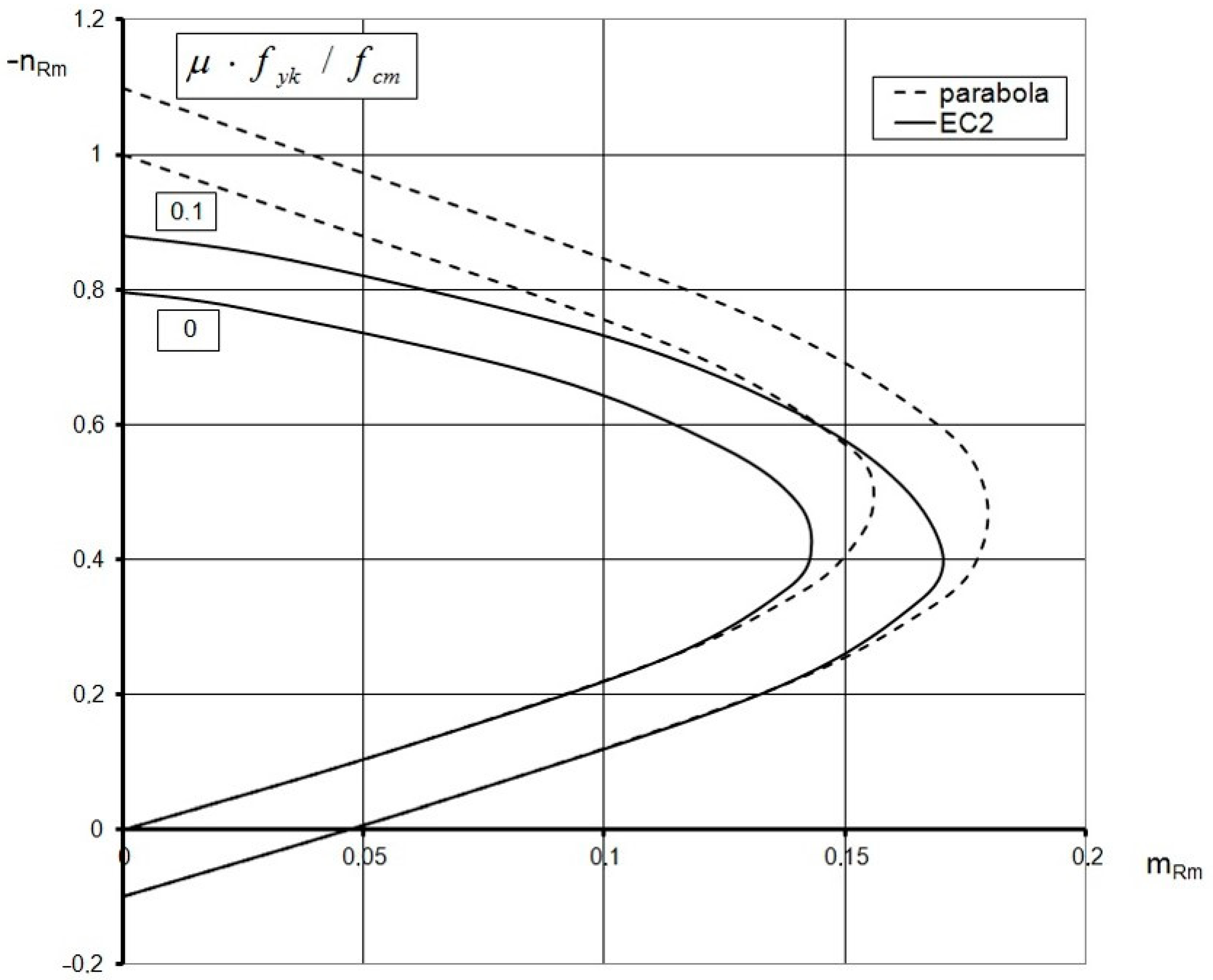
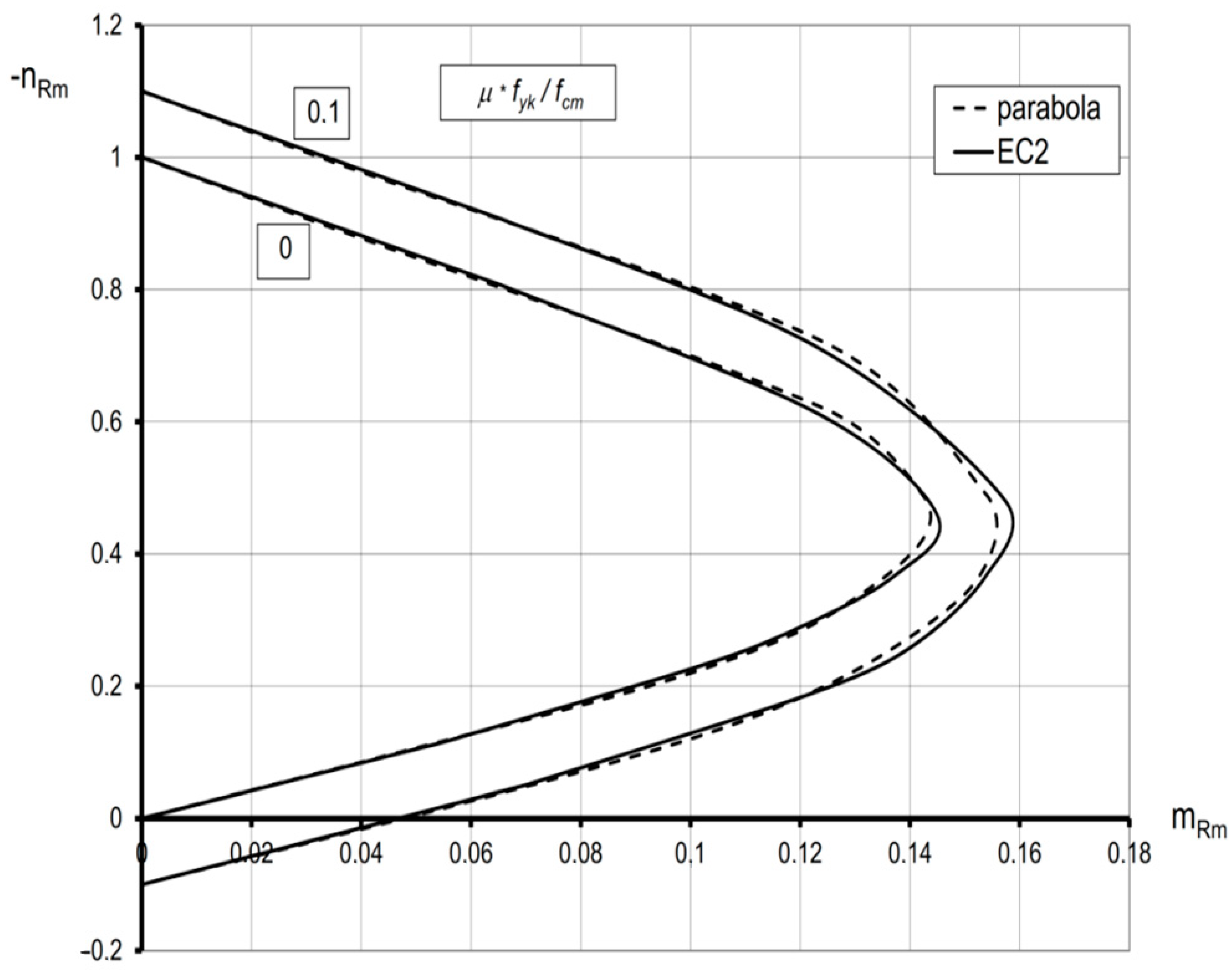

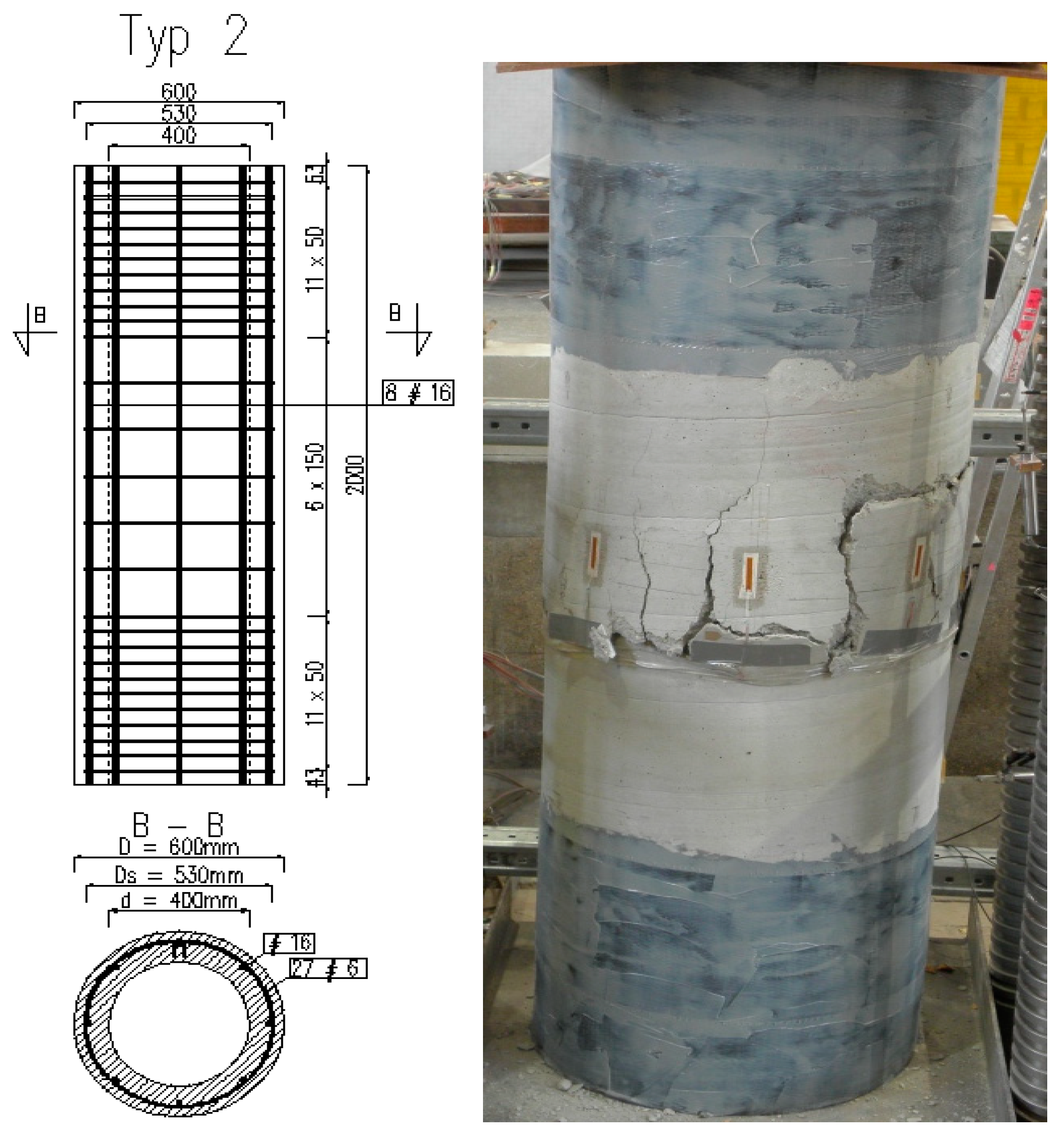
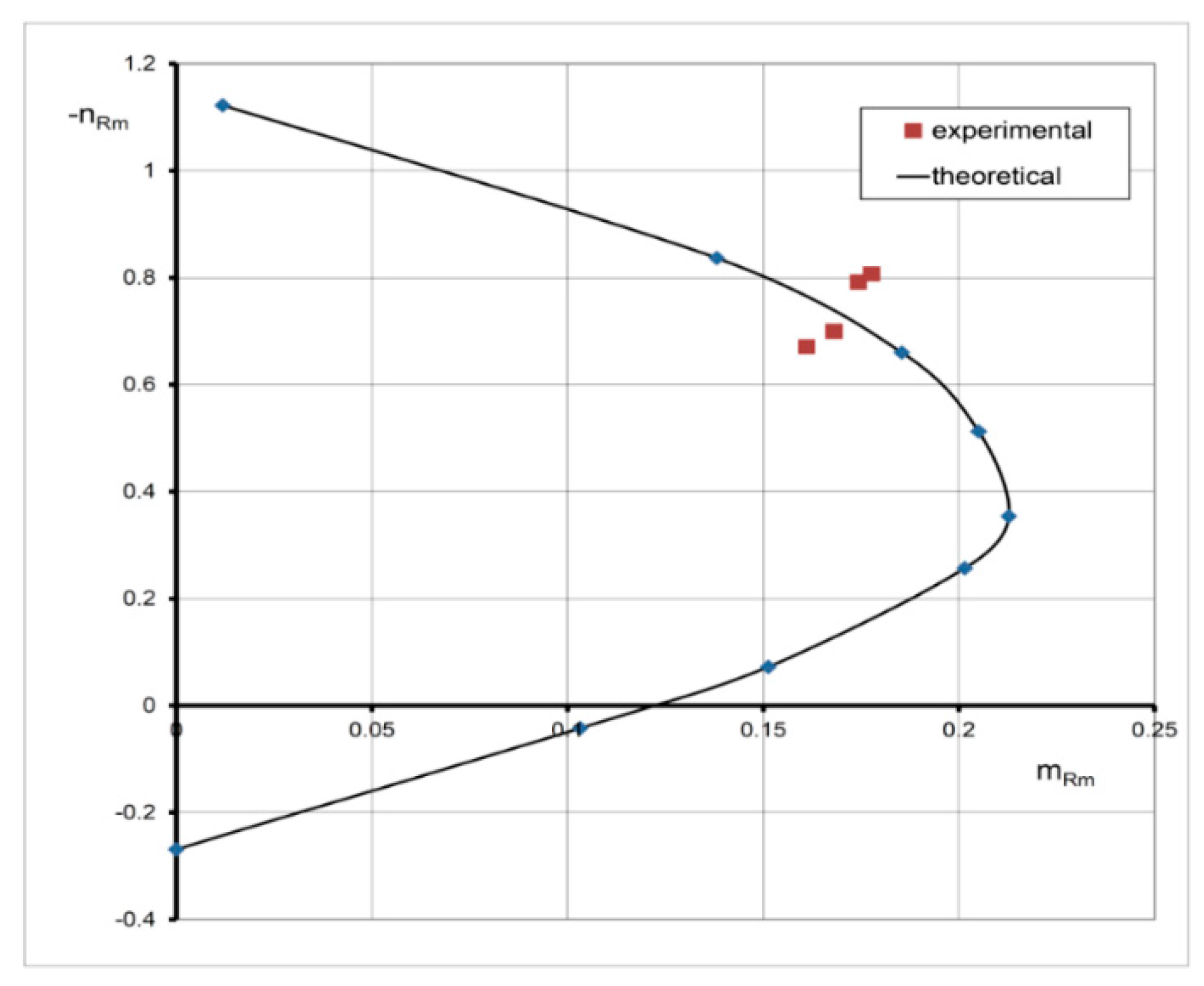
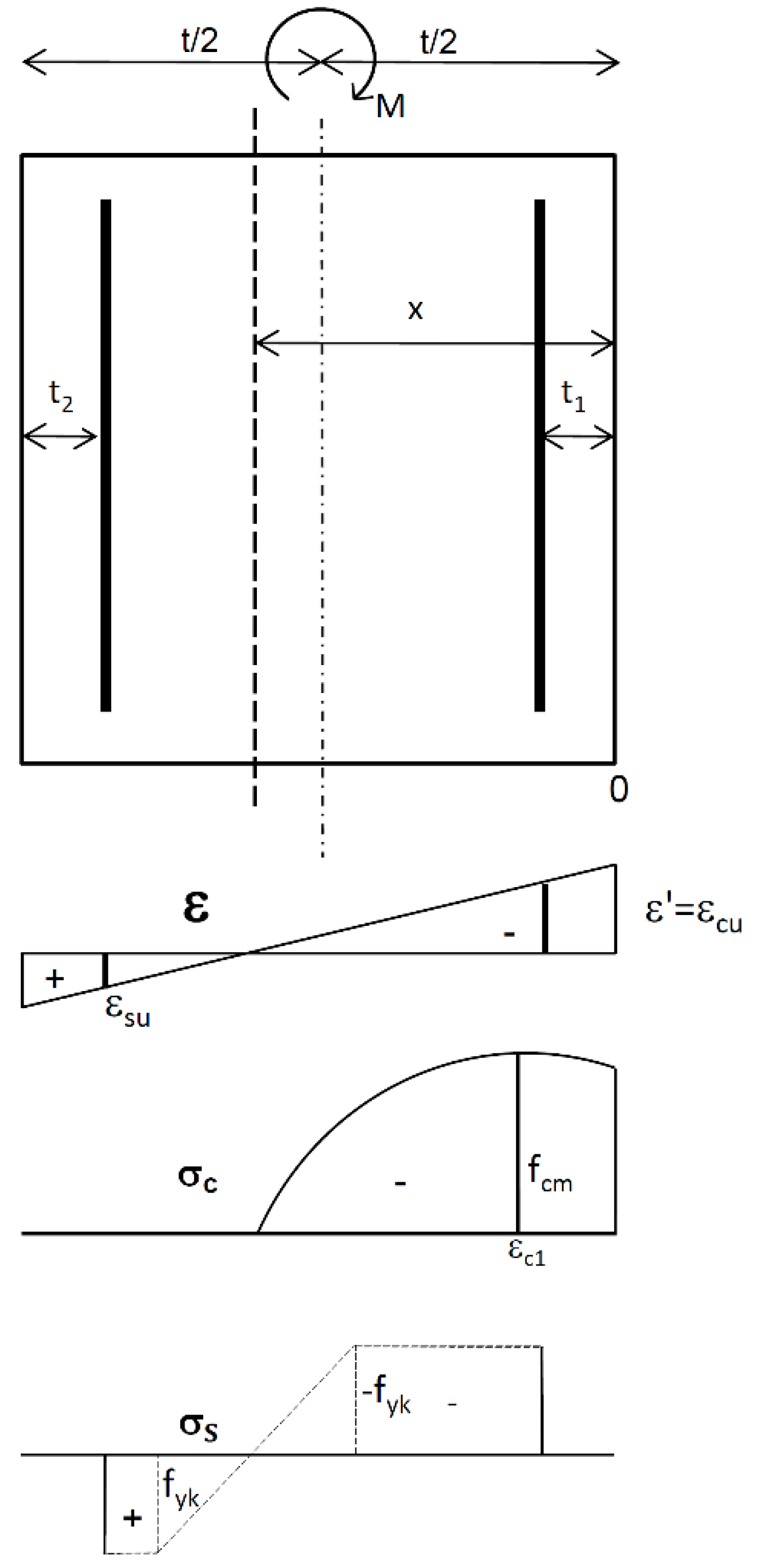
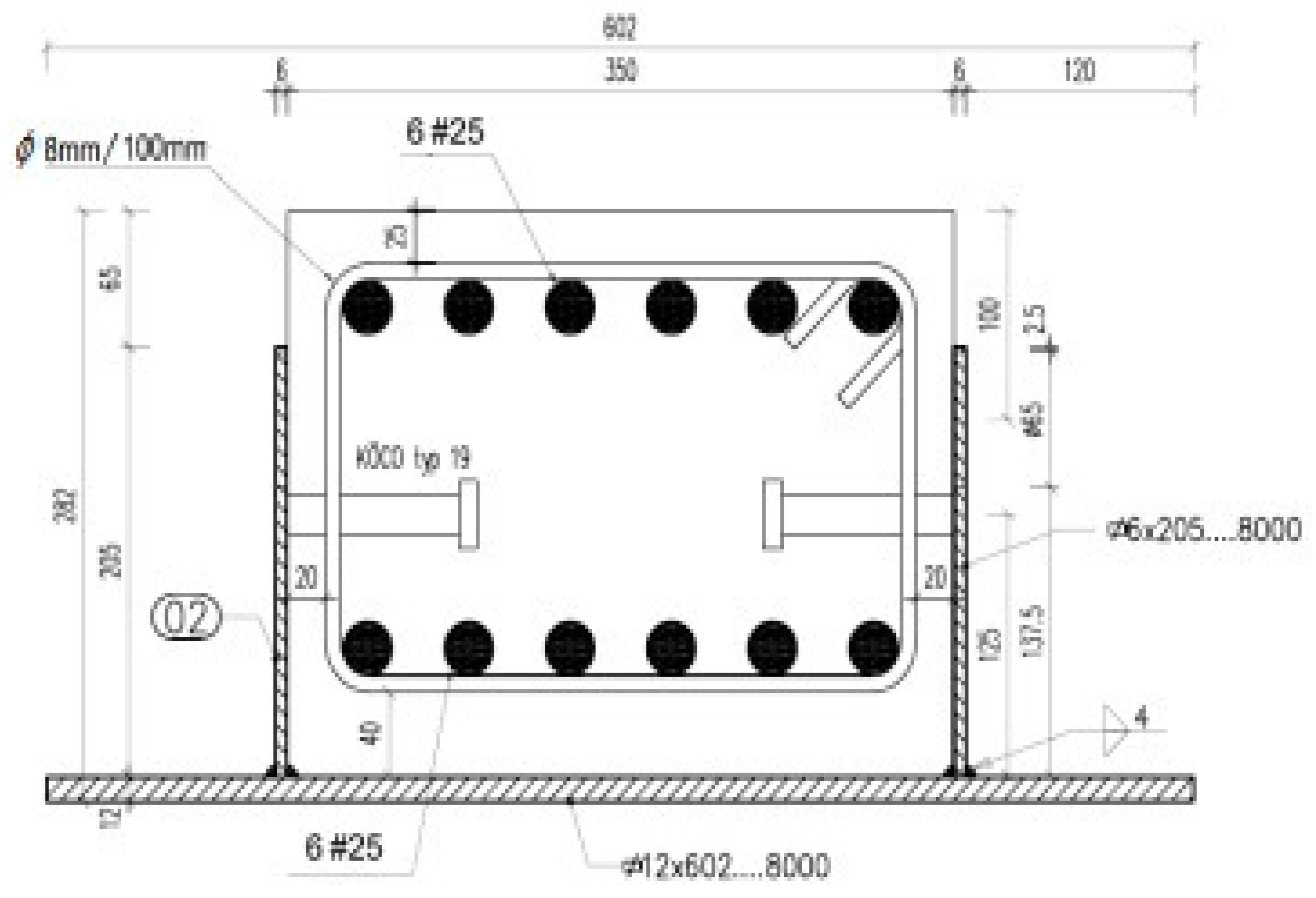
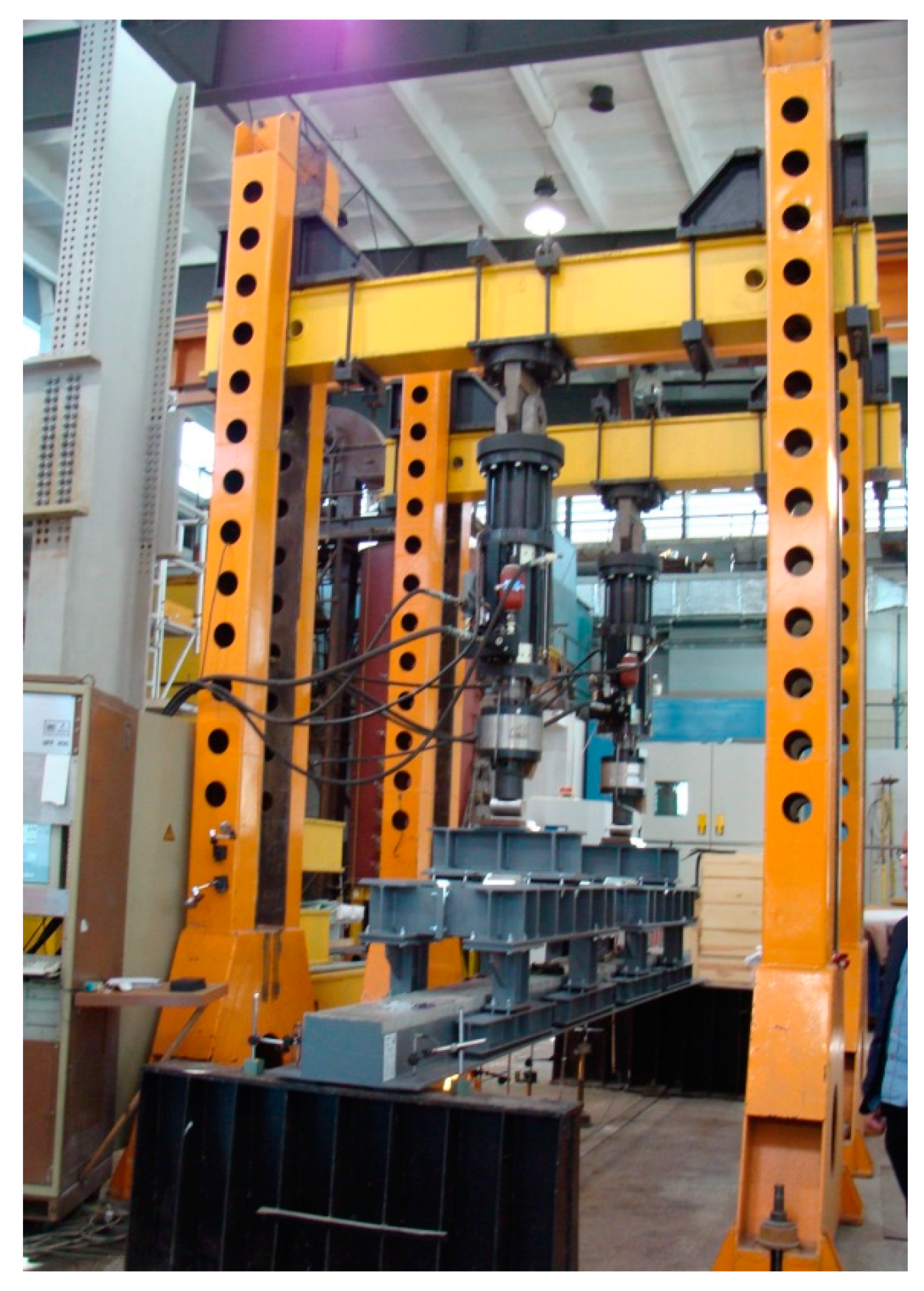
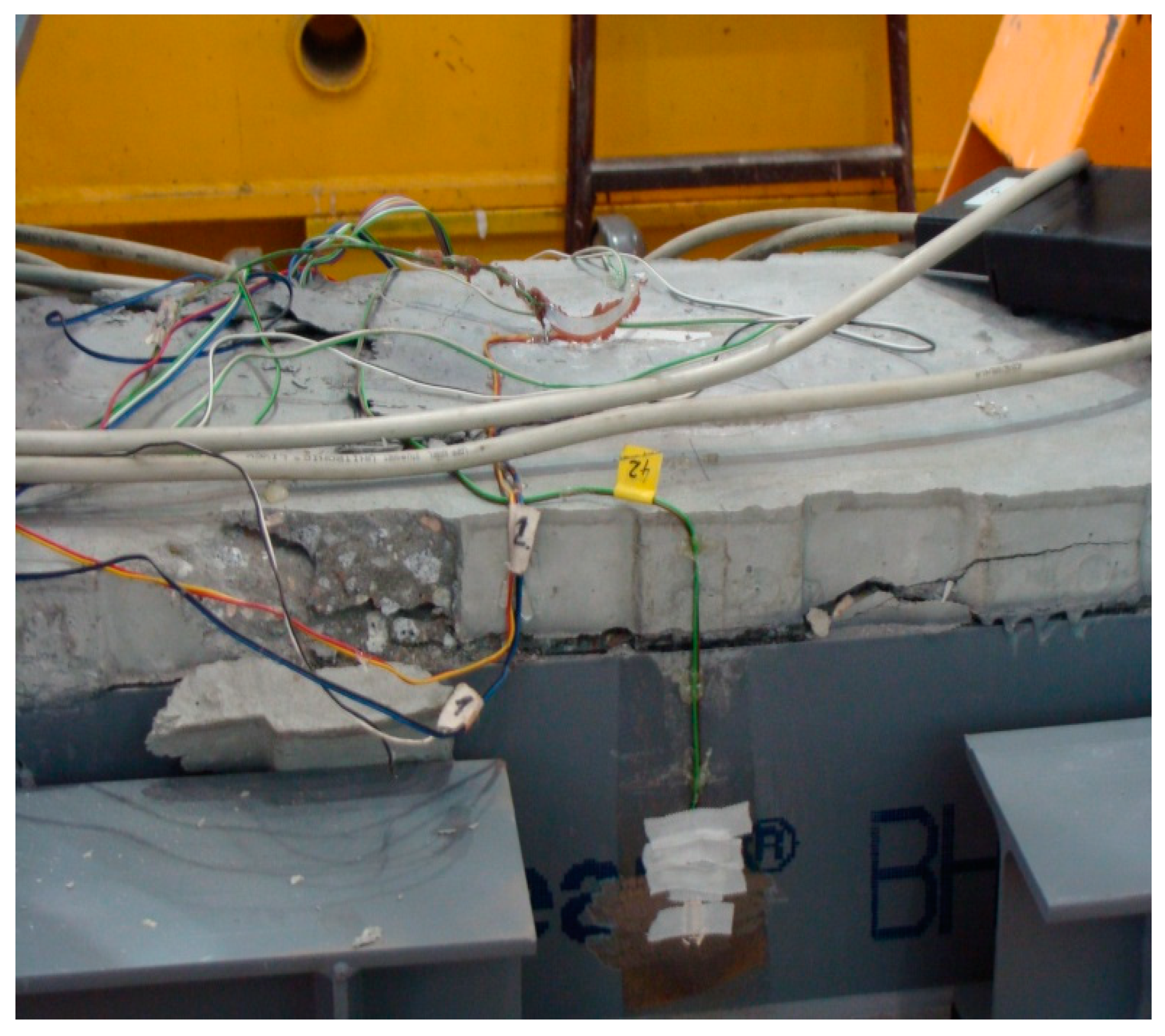
| Load Eccentricity (cm) | Failure Load (kN) | Ultimate Compressive Strain in Concrete (‰) |
|---|---|---|
| 11 | 2490 | 2.6 |
| 12 | 2110 | 2.5 |
| 12 | 2200 | 2.5 |
| 11 | 2535 | 3.4 |
| Concrete | Reinforcement in Compression | Reinforcement in Tension | Profile Steel | Failure Moment | Resistance |
|---|---|---|---|---|---|
| strain εc (‰) | strain εs1 (‰) | strain εs2 (‰) | strain εHf (‰) | Mu (kNm) | MHRm (kNm) |
| −3.21 | −2.89 | 1.15 | 2.22 | 902.8 | 847.7 |
| −3.04 | −2.13 | 1.13 | 2.25 | 883 | 842.4 |
| −2.90 | −2.0 | 1.25 | 2.28 | 910.7 | 854.8 |
Publisher’s Note: MDPI stays neutral with regard to jurisdictional claims in published maps and institutional affiliations. |
© 2022 by the author. Licensee MDPI, Basel, Switzerland. This article is an open access article distributed under the terms and conditions of the Creative Commons Attribution (CC BY) license (https://creativecommons.org/licenses/by/4.0/).
Share and Cite
Lechman, M. Cross-Sectional Analysis of the Resistance of RC Members Subjected to Bending with/without Axial Force. Materials 2022, 15, 1957. https://doi.org/10.3390/ma15051957
Lechman M. Cross-Sectional Analysis of the Resistance of RC Members Subjected to Bending with/without Axial Force. Materials. 2022; 15(5):1957. https://doi.org/10.3390/ma15051957
Chicago/Turabian StyleLechman, Marek. 2022. "Cross-Sectional Analysis of the Resistance of RC Members Subjected to Bending with/without Axial Force" Materials 15, no. 5: 1957. https://doi.org/10.3390/ma15051957
APA StyleLechman, M. (2022). Cross-Sectional Analysis of the Resistance of RC Members Subjected to Bending with/without Axial Force. Materials, 15(5), 1957. https://doi.org/10.3390/ma15051957






